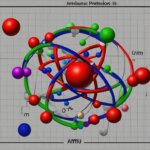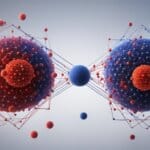Table of Contents
An electron, as a subatomic particle, plays a critical role in the structure of atoms. It is part of the atom’s atomic structure and exhibits unique characteristics. This article will delve into the fundamentals of electrons, shedding light on their nature and behavior.
So, what exactly is an electron? It is a subatomic particle that carries a negative charge. Unlike protons and neutrons, which are bound to the atom’s nucleus, an electron exists outside the nucleus. It is considered an elementary particle since it cannot be further divided into smaller components.
One intriguing aspect of electrons is their wave-particle duality. They exhibit both wave-like and particle-like characteristics, adding to their mystique. Rather than following fixed trajectories, an electron’s movement is determined by calculating the probability of finding it in specific regions surrounding the nucleus. This concept challenges the traditional notion of precise orbits.
Understanding the structure of electrons is fundamental to comprehending their behavior within an atom. In the next section, we will explore the concept of shells, subshells, and orbitals, which organize and define the arrangement of electrons in an atom.
The Structure of Electrons: Shells, Subshells, and Orbitals
Understanding the structure of electrons within an atom is crucial for comprehending the intricacies of atomic composition. This section explores the organization of electrons into shells, subshells, and orbitals, shedding light on their fascinating arrangement.
Shells:
Shells are regions of probability surrounding the nucleus in an atom. The number of electron shells can vary depending on the specific atom, with a maximum of seven shells in some cases. Each shell is confined to a particular number of electrons, determined by its level and configuration. The energy of the electrons increases as we move to higher-numbered shells.
Subshells:
Subshells are specific types of orbitals within a shell. They are identified as s, p, d, and f. These subshells further divide the electron distribution within a shell. Each subshell has a specific shape and orientation, representing the probability of finding an electron in a particular region.
Orbitals:
An orbital is a three-dimensional region of space where an electron is most likely to be found. Each orbital can accommodate a maximum of two electrons, each with opposite spin. The shape of an orbital depends on its subshell designation. The s subshell has a spherical shape, while the p subshell takes on a dumbbell or cloverleaf shape.
To provide further clarity, the following table highlights the maximum number of electrons in each shell and the corresponding subshells:
| Shell | Number of Subshells | Subshell Designations | Total Number of Electrons |
|---|---|---|---|
| 1 | 1 | s | 2 |
| 2 | 2 | s, p | 8 |
| 3 | 3 | s, p, d | 18 |
| 4 | 4 | s, p, d, f | 32 |
| 5 | 5 | s, p, d, f, g | 50 |
| 6 | 6 | s, p, d, f, g, h | 72 |
| 7 | 7 | s, p, d, f, g, h, i | 98 |
As electrons occupy these shells, subshells, and orbitals, they contribute to an atom’s chemical properties and bonding capabilities. Their specific arrangement dictates the electron configuration, which is vital for understanding an element’s reactivity and bonding characteristics.
Electron Movement and Quantum Theory
The movement of electrons within an atom is governed by the principles of quantum theory. Unlike the outdated Bohr model, which suggested fixed trajectories for electron movement, quantum theory takes a different approach. It focuses on calculating the probability of electron presence in specific regions surrounding the atomic nucleus. This recognition of the complex distribution and inhabitation of electrons in the space around the nucleus revolutionizes our understanding of electron behavior.
Quantum theory introduces the concept of mathematically defined regions called orbitals. These orbitals determine the most probable location of electrons within an atom. The study of electron movement is crucial in various scientific and technological domains, revealing insights into fundamental atomic mechanisms and enabling advancements in diverse fields.
“The simple idea that energy is quantized is so powerful that it inspired the development of a whole new branch of physics: quantum mechanics.”
One of the key aspects to note about electron movement is its role in the release of electromagnetic radiation. When an electron jumps between energy orbits, there is a corresponding emission or absorption of energy in the form of photons. This phenomenon underlies numerous natural and human-made processes, ranging from light emission in fluorescent lamps to the chemical reactions that drive life itself.
To gain a deeper understanding of electron movement and its implications, let’s explore some fundamental concepts of quantum theory:
The Uncertainty Principle
According to the uncertainty principle, formulated by Werner Heisenberg, it is impossible to simultaneously determine both the exact position and momentum of an electron. This principle introduces a fundamental limitation on our ability to precisely measure the properties of electrons and other subatomic particles. Instead, we can only determine the probability distribution of finding an electron within a given space.
Wave-Particle Duality
One of the intriguing aspects of electrons is their dual nature as both particles and waves. Electrons can exhibit wave-like behavior, such as diffraction and interference when passing through narrow slits or encountering obstacles. This wave-particle duality is a central tenet of quantum theory and highlights the inherent mystery and complexity of electron behavior.
Quantum Superposition
The concept of quantum superposition states that an electron can exist in multiple states simultaneously. Instead of having a fixed value for its properties, such as position and momentum, an electron can be in a state of superposition where it exists in a combination of different states. This idea challenges our classical notions of determinism and introduces a new probabilistic description of electron behavior.
Overall, the study of electron movement and quantum theory is a fascinating journey into the microscopic world of atoms and subatomic particles. It reveals the intricacies of how electrons navigate within atomic structures and interact with various forms of energy. From its theoretical foundations to practical applications, quantum theory’s insights deepen our understanding of the fundamental building blocks of the universe.
Electrons and Electricity
Electrons play a vital role in the world of electricity. Understanding their behavior and charge is crucial to comprehending how electric currents are generated and harnessed.
In electrical conductors, such as copper or aluminium, electrons have the freedom to move from atom to atom, creating a flow of electric charge. These materials are excellent conductors due to their abundance of free-moving electrons, which allow electric current to easily pass through them. This phenomenon is utilized in various applications, including electrical wiring, circuitry, and power transmission.
On the other hand, in semiconductor materials like silicon or germanium, electric current arises from both the movement of electrons and the existence of electron deficiencies known as holes. When an electron moves to fill a hole, it creates an electric charge imbalance, resulting in current flow. Semiconductors are used extensively in electronic devices, such as transistors, diodes, and integrated circuits, contributing to the advancement of technology.
Electrons themselves carry a negative charge and are attracted to positively charged particles, such as protons. It is important to note that the charge of a single electron is referred to as the unit electrical charge. This charge is equal in magnitude but opposite in polarity to that of protons or holes. The interplay of these charges is what allows for the generation and flow of electric currents.
![]()
| Material | Main Characteristics |
|---|---|
| Electrical Conductors | Abundance of free electrons allows for easy flow of electric current. |
| Semiconductor Materials | Current arises from both electron movement and electron deficiencies called holes. |
Understanding the role of electrons in electricity is fundamental to comprehending the principles that drive numerous technological advancements and the functioning of electronic devices we rely on every day.
Additional Properties of Electrons
Electrons, as elementary particles, possess unique characteristics that contribute to their crucial role in the atomic structure. Belonging to the lepton family, electrons are identical to each other and have the smallest mass among charged particles, including charged leptons. These subatomic particles exhibit both particle and wave-like properties, allowing them to diffract and collide with other particles.
The arrangement of electrons within an atom’s orbitals and shells determines its electronic configuration, a key factor influencing the atom’s size and chemical activity. The electronic configuration reveals the distribution of electrons among different energy levels and determines the atom’s behavior in chemical reactions.
“The electronic configuration provides valuable insights into an atom’s properties and interactions.”
Furthermore, electrons possess an intrinsic angular momentum known as spin. This spin is an intrinsic property that remains constant when electrons swap positions with each other. The concept of spin is crucial in understanding the behavior and properties of electrons in various contexts, ranging from magnetic interactions to quantum mechanics.
To summarize, electrons are elementary particles with distinct properties that make them essential components of the atomic structure. Their identical nature, wave-particle duality, electronic configuration, and spin contribute to their significant role in chemical reactions, magnetic interactions, and quantum phenomena.
The Dual Nature of Electrons
Electrons exhibit both wave-like and particle-like properties, a concept known as wave-particle duality. This duality emerged from the experiments and observations of early quantum physicists, such as the famous double-slit experiment.
In the double-slit experiment, a beam of particles, including electrons, is directed towards a barrier with two narrow slits. The resulting pattern on the observation screen exhibits interference fringes, characteristic of wave behavior. This phenomenon indicates that electrons, despite being considered particles, also exhibit wave behavior and interfere with themselves.
This wave-particle duality plays a significant role in understanding the behavior of electrons in various scientific disciplines, ranging from quantum mechanics to materials science.
An Introduction to Electronic Configuration
The electronic configuration of an atom describes how its electrons are distributed among different orbitals and shells. It reveals valuable insights into an atom’s stability, reactivity, and physical properties.
The electronic configuration follows a specific set of rules based on the principles of quantum mechanics. These rules determine the filling of orbitals and the order in which electrons occupy them. The most commonly used notation for representing electronic configurations is the noble gas notation, where the electron configurations of noble gases are used as a reference.
For instance, the electronic configuration of carbon is 1s2 2s2 2p2. This notation indicates that carbon has two electrons in its 1s orbital, two electrons in its 2s orbital, and two electrons in its 2p orbitals.
The electronic configuration not only determines an atom’s chemical properties but also influences its size, ionization energy, and ability to form chemical bonds.
Figure: Representation of electron spin
Historical Background and Discoveries
The existence of electrons was predicted by several scientists, including Richard Laming and G. Johnstone Stoney. The term “electron” was first suggested by G. Johnstone Stoney in 1891. However, it was not until 1897 that British physicist J.J. Thomson discovered electrons during investigations of cathode rays. Thomson’s discovery revolutionized knowledge of atomic structure, as electrons were found to be fundamental to the composition of atoms. Electrons are the primary carriers of electric current in solids and play crucial roles in various scientific and technological applications.
FAQ
What is an electron?
An electron is a subatomic particle with a negative charge that is part of the atom’s structure.
How are electrons organized within an atom?
Electrons are organized into shells, subshells, and orbitals. Shells are regions of probability surrounding the nucleus, subshells are specific types of orbitals, and orbitals are regions of space where electrons are likely to be found.
How are electron movements described in quantum theory?
Electron movements are determined by calculating the probability of finding them in specific regions surrounding the nucleus. This is in contrast to the outdated Bohr model, which proposed fixed trajectories.
What role do electrons play in electricity?
Electrons are responsible for the flow of electricity in conductors and semiconductors. They carry a negative charge and are attracted to positively charged particles.
What are some additional properties of electrons?
Electrons are considered elementary particles, have both particle and wave-like properties, and have a spin or intrinsic angular momentum.
Who discovered electrons?
Electrons were discovered by British physicist J.J. Thomson in 1897 during investigations of cathode rays. They were found to be fundamental to the composition of atoms.













